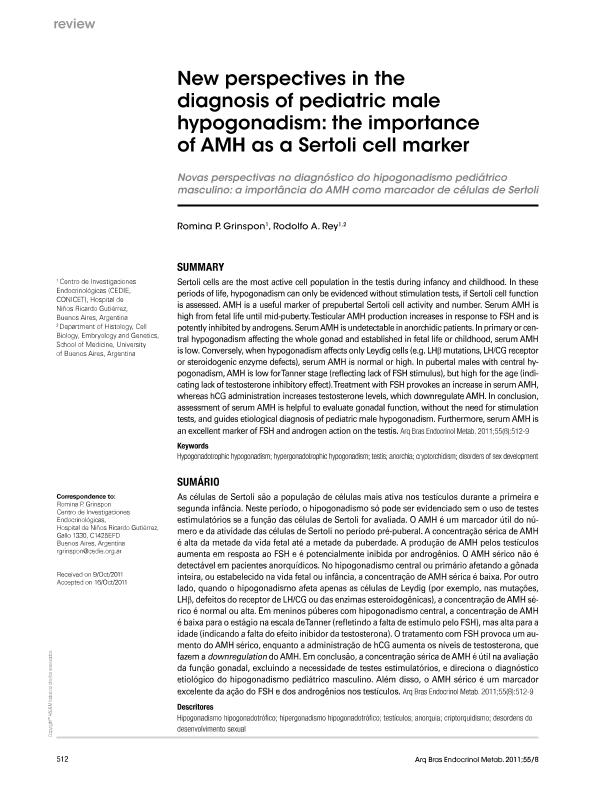Mostrar el registro sencillo del ítem
dc.contributor.author
Grinspon, Romina

dc.contributor.author
Rey, Rodolfo Alberto

dc.date.available
2020-02-14T20:19:14Z
dc.date.issued
2011-11
dc.identifier.citation
Grinspon, Romina; Rey, Rodolfo Alberto; New perspectives in the diagnosis of pediatric male hypogonadism: the importance of AMH as a Sertoli cell marker; Sociedade Brasileira de Endocrinologia e Metabologia; Arquivos Brasileiros de Endocrinologia e Metabologia; 55; 8; 11-2011; 512-519
dc.identifier.issn
1677-9487
dc.identifier.uri
http://hdl.handle.net/11336/97634
dc.description.abstract
Sertoli cells are the most active cell population in the testis during infancy and childhood. In these periods of life, hypogonadism can only be evidenced without stimulation tests, if Sertoli cell function is assessed. AMH is a useful marker of prepubertal Sertoli cell activity and number. Serum AMH is high from fetal life until mid-puberty. Testicular AMH production increases in response to FSH and is potently inhibited by androgens. Serum AMH is undetectable in anorchidic patients. In primary or central hypogonadism affecting the whole gonad and established in fetal life or childhood, serum AMH is low. Conversely, when hypogonadism affects only Leydig cells (e.g. LHb mutations, LH/CG receptor or steroidogenic enzyme defects), serum AMH is normal or high. In pubertal males with central hypogonadism, AMH is low for Tanner stage (reflecting lack of FSH stimulus), but high for the age (indicating lack of testosterone inhibitory effect). Treatment with FSH provokes an increase in serum AMH, whereas hCG administration increases testosterone levels, which downregulate AMH. In conclusion, assessment of serum AMH is helpful to evaluate gonadal function, without the need for stimulation tests, and guides etiological diagnosis of pediatric male hypogonadism. Furthermore, serum AMH is an excellent marker of FSH and androgen action on the testis.b mutations, LH/CG receptor or steroidogenic enzyme defects), serum AMH is normal or high. In pubertal males with central hypogonadism, AMH is low for Tanner stage (reflecting lack of FSH stimulus), but high for the age (indicating lack of testosterone inhibitory effect). Treatment with FSH provokes an increase in serum AMH, whereas hCG administration increases testosterone levels, which downregulate AMH. In conclusion, assessment of serum AMH is helpful to evaluate gonadal function, without the need for stimulation tests, and guides etiological diagnosis of pediatric male hypogonadism. Furthermore, serum AMH is an excellent marker of FSH and androgen action on the testis.
dc.description.abstract
As células de Sertoli são a população de células mais ativa nos testículos durante a primeira e segunda infância. Neste período, o hipogonadismo só pode ser evidenciado sem o uso de testes estimulatórios se a função das células de Sertoli for avaliada. O AMH é um marcador útil do número e da atividade das células de Sertoli no período pré-puberal. A concentração sérica de AMH é alta da metade da vida fetal até a metade da puberdade. A produção de AMH pelos testículos aumenta em resposta ao FSH e é potencialmente inibida por androgênios. O AMH sérico não é detectável em pacientes anorquídicos. No hipogonadismo central ou primário afetando a gônada inteira, ou estabelecido na vida fetal ou infância, a concentração de AMH sérica é baixa. Por outro lado, quando o hipogonadismo afeta apenas as células de Leydig (por exemplo, nas mutações, LHb, defeitos do receptor de LH/CG ou das enzimas esteroidogênicas), a concentração de AMH sérico é normal ou alta. Em meninos púberes com hipogonadismo central, a concentração de AMH é baixa para o estágio na escala de Tanner (refletindo a falta de estímulo pelo FSH), mas alta para a idade (indicando a falta do efeito inibidor da testosterona). O tratamento com FSH provoca um aumento do AMH sérico, enquanto a administração de hCG aumenta os níveis de testosterona, que fazem a downregulation do AMH. Em conclusão, a concentração sérica de AMH é útil na avaliação da função gonadal, excluindo a necessidade de testes estimulatórios, e direciona o diagnóstico etiológico do hipogonadismo pediátrico masculino. Além disso, o AMH sérico é um marcador excelente da ação do FSH e dos androgênios nos testículos
dc.format
application/pdf
dc.language.iso
eng
dc.publisher
Sociedade Brasileira de Endocrinologia e Metabologia

dc.rights
info:eu-repo/semantics/openAccess
dc.rights.uri
https://creativecommons.org/licenses/by-nc-sa/2.5/ar/
dc.subject
ANORCHIA
dc.subject
CRYPTORCHIDISM
dc.subject
DISORDERS OF SEX DEVELOPMENT
dc.subject
HYPERGONADOTROPHIC HYPOGONADISM
dc.subject
HYPOGONADOTROPHIC HYPOGONADISM
dc.subject
TESTIS
dc.subject.classification
Endocrinología y Metabolismo

dc.subject.classification
Medicina Clínica

dc.subject.classification
CIENCIAS MÉDICAS Y DE LA SALUD

dc.title
New perspectives in the diagnosis of pediatric male hypogonadism: the importance of AMH as a Sertoli cell marker
dc.title
Novas perspectivas no diagnóstico do hipogonadismo pediátrico masculino: a importância do AMH como marcador de células de Sertoli
dc.type
info:eu-repo/semantics/article
dc.type
info:ar-repo/semantics/artículo
dc.type
info:eu-repo/semantics/publishedVersion
dc.date.updated
2020-02-07T13:48:58Z
dc.journal.volume
55
dc.journal.number
8
dc.journal.pagination
512-519
dc.journal.pais
Brasil

dc.journal.ciudad
San Pablo
dc.description.fil
Fil: Grinspon, Romina. Gobierno de la Ciudad de Buenos Aires. Hospital General de Niños "Ricardo Gutiérrez"; Argentina. Consejo Nacional de Investigaciones Científicas y Técnicas; Argentina
dc.description.fil
Fil: Rey, Rodolfo Alberto. Gobierno de la Ciudad de Buenos Aires. Hospital General de Niños "Ricardo Gutiérrez"; Argentina. Consejo Nacional de Investigaciones Científicas y Técnicas; Argentina. Universidad de Buenos Aires. Facultad de Medicina. Departamento de Biología Celular e Histología; Argentina
dc.journal.title
Arquivos Brasileiros de Endocrinologia e Metabologia

dc.relation.alternativeid
info:eu-repo/semantics/altIdentifier/url/http://www.scielo.br/scielo.php?script=sci_arttext&pid=S0004-27302011000800003
dc.relation.alternativeid
info:eu-repo/semantics/altIdentifier/doi/https://doi.org/10.1590/S0004-27302011000800003
Archivos asociados
